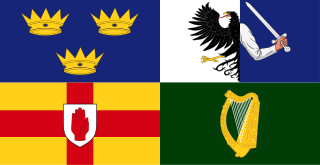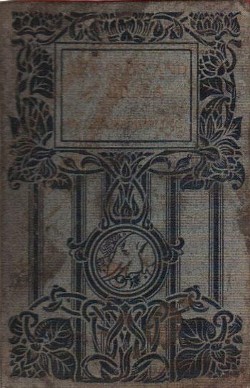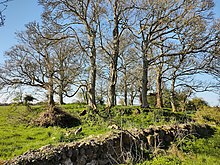
Aos sí is the Irish name for a supernatural race in Celtic mythology – daoine sìth in Scottish Gaelic – comparable to fairies or elves. They are said to descend from the Tuatha Dé Danann, meaning the 'People of Danu', depending on the Abrahamic or pagan tradition.

In English folklore, The Puck, also known as Goodfellows, are/is a domestic and nature sprite, demon, or fairy.

A fairy is a type of mythical being or legendary creature, generally described as anthropomorphic, found in the folklore of multiple European cultures, a form of spirit, often with metaphysical, supernatural, or preternatural qualities.

A leprechaun is a diminutive supernatural being in Irish folklore, classed by some as a type of solitary fairy. They are usually depicted as little bearded men, wearing a coat and hat, who partake in mischief. In later times, they have been depicted as shoe-makers who have a hidden pot of gold at the end of the rainbow.
A trow is a malignant or mischievous fairy or spirit in the folkloric traditions of the Orkney and Shetland islands. Trows may be regarded as monstrous giants at times, or quite the opposite, short-statured fairies dressed in grey.

A pixie is a mythical creature of British folklore. Pixies are speculated to be particularly concentrated in the high moorland areas around Devon and Cornwall, suggesting some Celtic origin for the belief and name. However, the word 'pixie' also appears in Dorset, Somerset and to a lesser extent in Sussex, Wiltshire and Hampshire.

Rathcroghan is a complex of archaeological sites near Tulsk in County Roscommon, Ireland. It is identified as the site of Cruachan, the traditional capital of the Connachta, the prehistoric and early historic rulers of the western territory. The Rathcroghan Complex is a unique archaeological landscape with many references found in early Irish medieval manuscripts.

The púca, pucapwca, pooka, phouka, puck is a creature of Celtic, English, and Channel Islands folklore. Considered to be bringers both of good and bad fortune, they could help or hinder rural and marine communities. Púcaí can have dark or white fur or hair. The creatures were said to be shape-changers that could take the appearance of horses, goats, cats, dogs, and hares. They may also take a human form, which includes various animal features, such as ears or a tail.
Fairies, particularly those of Irish, English, Scottish and Welsh folklore, have been classified in a variety of ways. Classifications – which most often come from scholarly analysis, and may not always accurately reflect local traditions – typically focus on behavior or physical characteristics.

Ringforts or ring forts are small circular fortified settlements built during the Bronze Age, Iron Age and early Middle Ages up to about the year 1000 AD. They are found in Northern Europe, especially in Ireland. There are also many in South Wales and in Cornwall, where they are called rounds. Ringforts come in many sizes and may be made of stone or earth. Earthen ringforts would have been marked by a circular rampart, often with a stakewall. Both stone and earthen ringforts would generally have had at least one building inside.

The Dullahan, also called Colainn Gan Cheann, is a type of legendary creature in Irish folklore. He is depicted as a headless rider, on a black horse, who carries his own head held high in his hand or under his arm.

Irish folklore refers to the folktales, balladry, music, dance and mythology of Ireland. It is the study and appreciation of how people lived.

A lutin is a type of hobgoblin in French folklore and fairy tales. Female lutins are called lutines.

Caherconnell is an exceptionally well-preserved medieval stone ringfort in region known as the Burren, County Clare, Ireland. It lies about 1 km south of the Poulnabrone dolmen.

Thomas Johnson Westropp was an Irish antiquarian, folklorist and archaeologist.

Puck of Pook's Hill is a fantasy book by Rudyard Kipling, published in 1906, containing a series of short stories set in different periods of English history. It can count both as historical fantasy – since some of the stories told of the past have clear magical elements, and as contemporary fantasy – since it depicts a magical being active and practising his magic in the England of the early 1900s when the book was written.
According to folklore a fairy path is a route taken by fairies usually in a straight line and between sites of traditional significance, such as fairy forts or raths, "airy" (eerie) mountains and hills, thorn bushes, springs, lakes, rock outcrops, and Stone Age monuments. Ley lines and spirit paths, such as with corpse roads, have some similarities with these fairy paths. A fairy ring is also a path used by fairies, but in a circle, for dancing, as described by poet W. B. Yeats, "...the fairies dance in a place apart, Shaking their milk-white feet in a ring,..." The concept is usually associated with Celtic folklore, especially that of Ireland.

Rewards and Fairies is a historical fantasy book by Rudyard Kipling published in 1910. The title comes from the poem "Farewell, Rewards and Fairies" by Richard Corbet, which was referred to by the children in the first story of Kipling's earlier book Puck of Pook's Hill. Rewards and Fairies, a followup to Puck, is set one year later, although it was published four years afterwards.














